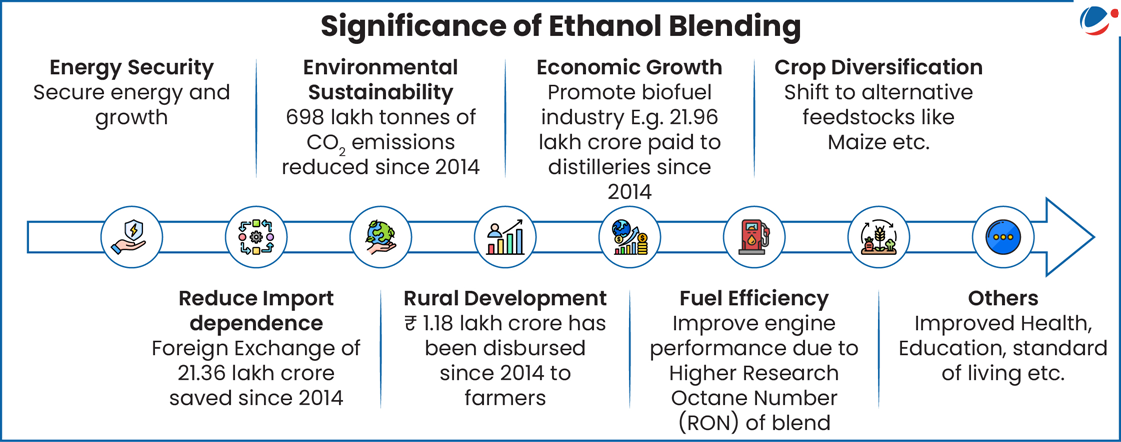Why in the News?
Union Minister for Petroleum and Natural Gas announced India's achievement of 20% Ethanol blending target in petrol.
More on the News
- The target was achieved as envisaged in Ethanol Blended Petrol (EBP) Programme.
- Ethanol blending in petrol increased from 1.5% in 2014 to 20% in 2025 (Nearly 13-fold increase).
About Ethanol
|
About Ethanol Blended Petrol (EBP) Programme
- Genesis: Launched in 2003 to promote blending of ethanol in petrol.
- About Ethanol Blending
- Definition: Ethanol blending refers to the process of mixing ethanol with petrol to create a more sustainable and cleaner burning fuel.
- Types: E10 (10% Ethanol by Volume), E20 (20% Ethanol), E85 fuel (85% ethanol by volume).
- The use of E-20 gives better acceleration, better ride quality and lowered carbon emissions by approximately 30% as compared to E10 fuel.
- Target: National Policy on Biofuels (2018), as amended in 2022, advanced the target of 20% blending of ethanol in petrol to 2025-26 from 2030.
- National Policy on Biofuels:
- Use of Sugarcane Juice, Sugar Beet, Cassava, Damaged food grains, Rotten Potatoes, unfit for human consumption for ethanol production.
- Use of Surplus food grains to be used for ethanol production and blending with petrol.
- Achievement: Ethanol production increased from 38 crore liters in 2014 to over 660 crore liters in 2025.
- National Policy on Biofuels:

Challenges of Ethanol Blending in India
- Food Security and Inflation: Biofuel expansion could exacerbate food insecurity, particularly for vulnerable populations as per FAO Report 2023. E.g. Over diversion of food crops for ethanol production.
- Environment: Ethanol blending is heavily dependent on Sugarcane in India, a water intensive crop affecting water aquifers.
- Technological and Vehicle Cost: India's vehicle fleet transitioning to E20 and beyond requires modifications in engine design and fuel systems, which may be costly.
- Many older vehicles and two-wheelers lack ethanol-compatible parts, making them less tolerant to higher blends.
- Fuel efficiency and Vehicle Integrity: Ethanol, being lower in energy density than petrol, results in a marginal decrease in mileage.
- Older engines may struggle with air-fuel adjustments on ethanol blends, resulting in drivability and emissions problems.
- Ethanol is prone to water absorption and phase separation, increasing the risk of clogging and fuel system failures.
- Supply of Ethanol:
- Availability of ethanol across the country: E.g. Ethanol blending has not been taken up in North-East states due to non-availability of feedstock or industries or high cost of logistics.
- Restrictions on inter-state movement of ethanol due to non-implementation of the amended provisions of Industries (Development & Regulation) Act, 1951 by all the States.
- The high cost of logistics and transport related emissions due to Transport of ethanol to different places.
- The need for storage infrastructure for ethanol at marketing terminals / depots.
Initiatives facilitating Ethanol Blending
- PM JIVAN (Jaiv Indhan- Vatavaran Anukool fasal Awashesh Nivaran) Yojana: For providing financial support to integrated bio-ethanol projects for setting up Second Generation (2G) ethanol projects
- Ethanol Interest Subvention Schemes (EISS) launched to foster the establishment of Dedicated Ethanol Plants (DEPs).
- Reduction in GST on ethanol meant for EBP Programme from 18% to 5%. However, crude ethanol still continues to be taxed at 18%.
- Amendment to Industries (Development & Regulation) Act, 1951 for smooth movement of ethanol across country.
Conclusion
India's commitment to ethanol blending represents a transformative approach to energy security, environmental sustainability, and economic development. With potential biodiesel in pipeline, care must be taken to cater to the challenges encountered in the ethanol-blended petrol introduction. A phased roll-out is thus the need of the hour.



